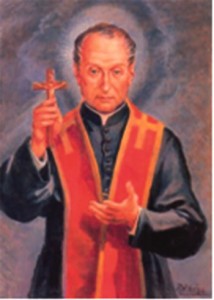June Saints
 Saint Gaspar Bertoni (1777-1835)
Saint Gaspar Bertoni (1777-1835)
Gaspar Bertoni, son of a wealthy lawyer and notary, was born in 1777 in Verona, Italy, to a pious family. Following the death of his baby sister, he remained the only child. He was educated first at home, then by Jesuits and the Marian Congregation. At his first Holy Communion, he was blessed with a vision and a message that he was to enter the priesthood. He entered the seminary in 1796. That year, troops from Revolutionary France began a 20-year occupation of northern Italy. Gaspar joined the Gospel Fraternity for the Hospitals and worked to help those wounded, ill, displaced or otherwise harmed by the occupation.
After ordination, Father Gaspar found himself in a world disturbed by numerous problems. He was assigned to care for the youth of the parish and to prepare children for their First Communion. He started a youth programme similar to the one later adopted by St John Bosco.
In October 1812, Father Bertoni became fatally ill with tuberculosis. But, after hovering near death for days, he recovered but was to suffer poor health for the rest of his days. A mission in early May 1816 inspired him to found the Congregation of the Sacred Stigmata of Our Lord Jesus, dedicated to “going everywhere into the diocese and the world”. The new community lived together a common life of strict observance and penance. Their apostolate included the Christian education of youth, the formation of the clergy, missionary preaching and perfect availability to the requests of the bishop.
Over the years following his first illness, Father Bertoni endured over 300 operations, all without anaesthesia, to lacerate leg ulcers and remove gangrene which invaded his right leg. At age 61, he was confined to his bedroom “between his bed and wheelchair.” He spent the remaining 14 years of his life in that bare room with empty walls, adorned only by his beloved crucifix. He could not suffer enough for the good of the church and the salvation of souls. From his bed, he continued to serve as counsellor and spiritual director. He died on 12 June 1835.
Saint Gaspar, help me to suffer willingly for the salvation of souls.
(http://www.vatican.va/news_services/liturgy/saints/ns_lit_doc_19891101_bertoni_en.html)
 Saint Etheldreda (d. 679)
Saint Etheldreda (d. 679)
Etheldreda was daughter of King Anna of the East Angles and married one Tonbert, who died three years later. She then retired to the isle of Ely, but after five years married again, young Prince Egfrid of Northumbria: however, she refused to consummate the marriage and, with the support of Saint Wilfrid, received the veil of a nun.
About 672 she founded a double monastery at Ely and governed it till her death in 679, setting a high example of asceticism and prayerfulness. A very large number of churches were dedicated in honour of this princess, whose feast is still observed in several English dioceses.
Saint Etheldreda, help me to acquire a spirit of prayer.
(Source: A New Dictionary of the Saints, Donald Attwater. 1993 Burns & Oates, Kent)
 Saint Cyril of Alexandria (c. 376-444)
Saint Cyril of Alexandria (c. 376-444)
Saint Cyril was born at Alexandria, Egypt. He received a classical and theological education at Alexandria and was ordained by his uncle. He succeeded his uncle as patriarch of Alexandria on Theophilus’ death in 412.
In 430 Cyril became embroiled with Nestorius, patriarch of Constantinople, who was preaching that Mary was not the Mother of God since Christ was Divine and not human, and consequently she should not have the word theotokos (God-bearer) applied to her. Cyril presided over the third General Council at Ephesus, attended by some two hundred bishops, which condemned all the tenets of Nestorius and his followers before the arrival of Archbishop John of Antioch and forty-two followers who believed Nestorius was innocent. When they found what had been done, they held a council of their own and deposed Cyril. Two years later, Nestorius was forced into exile.
During the rest of his life, Cyril wrote treatises that clarified the doctrines of the Trinity and the Incarnation and that helped prevent Nestorianism and Pelagianism from taking long-term deep root in the Christian community. He was the most brilliant theologian of the Alexandrian tradition. His writings are characterised by accurate thinking, precise exposition, and great reasoning skills. Among his writings are commentaries on John, Luke, and the Pentateuch, treatises on dogmatic theology, and Apologia against Julian the Apostate, and letters and sermons. He died in 444.
Saint Cyril, Help me to be willing to defend the teachings of the Church.
(http://www.catholic.org/saints/saint.php?saint_id=616)
 Entries(RSS)
Entries(RSS)